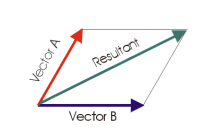Density and Pressure Scalars and Vectors First Law of Motion
See a collection of solved examples for this topic on our website buzztutor.com
Scalar or vector?
To explain the difference we use two words: 'magnitude' and 'direction'. By magnitude we mean how much of the quantity is there. By direction we mean is this quantity having a direction which defines it.
Physical quantities which are completely specified by just giving out there magnitude are known as scalars. Examples of scalar quantities are distance, mass, speed, volume, density and temperature.
Other physical quantities cannot be defined by just their magnitude. To define them completely we must also specify their direction. Examples of these are velocity, displacement, acceleration, force, torque and momentum. These are called vectors.
Parallelogram law of vector addition
If we were to represent the magnitude and direction of two vectors by two adjacent sides of a parallelogram. The resultant can then be represented in magnitude and direction by the diagonal. This diagonal is the one which passes through the point of intersection of these two sides.

Resolution of a vector
It is often necessary to split a vector into its components. Splitting of a vector into its components is called resolution of the vector. The original vector is the resultant of these components. When the components of a vector are at right angle to each other they are called the rectangular components of a vector.

In the figure above the green vector has been resolved into two vectors: blue and red. These vectors are at right angles to each other. The are the rectangular components of the green vector.